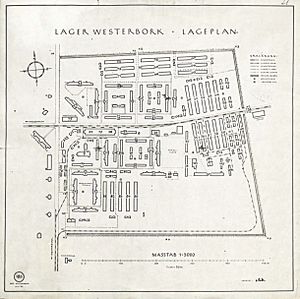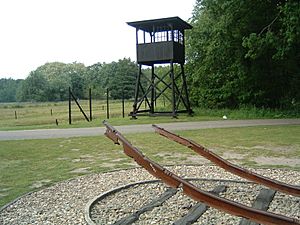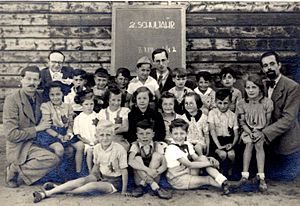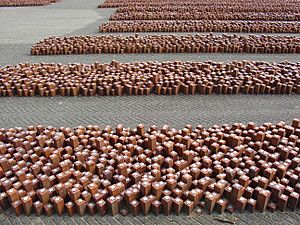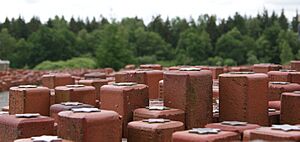Westerbork transit camp facts for kids
Quick facts for kids Westerbork |
|
|---|---|
| Transit camp | |
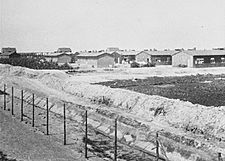
Barracks at Westerbork after liberation
|
|
| Coordinates | 52°55′3″N 6°36′26″E / 52.91750°N 6.60722°E |
| Other names | Polizeiliches Durchgangslager Westerbork, Judendurchgangslager Westerbork |
| Location | Westerbork, Netherlands |
| Operated by | SS |
| Original use | Refugee camp |
| Operational | 1939 – 1940 (as a refugee camp) 1 July 1942 – 12 April 1945 (as a transit camp) |
| Inmates | Jews |
| Number of inmates |
|
| Liberated by | Canadian 2nd Infantry Division |
| Notable inmates | Anne Frank, Margot Frank, Dora Gerson, Etty Hillesum, Philip Slier, Edith Stein, Selma Wijnberg-Engel, Max Ehrlich, Wilhelm Mautner, Ellen Burka, Walter Süskind, Settela Steinbach, Maurice Frankenhuis, Kurt Gerron |
| Notable books | The Night of the Girondins |
Camp Westerbork was a special camp in the Netherlands during World War II. It was located in the northeastern part of the country. The camp was used by the Nazis as a place to gather Jews, Sinti, and Roma before sending them to other, larger concentration camps or extermination camps. It is also known as Westerbork transit camp.
Contents
What Was Camp Westerbork For?
The Dutch government first built Camp Westerbork in 1939. It was meant to be a safe place for Germans and Austrians, especially Jewish people, who were escaping Nazism.
However, after Germany invaded the Netherlands in 1940, the camp's purpose changed. By 1942, the Nazis took control and turned Westerbork into a transit camp. This meant it was a temporary stop for people before they were sent to other camps.
The camp was not designed for mass killings. It had about 200 small cottages for families. These cottages had two rooms, a toilet, and a small cooking area. Single people stayed in long barracks with shared bathrooms.
Every Tuesday, from July 1942 to September 1944, trains arrived at Westerbork. They brought people who were then deported to other camps. About 97,776 Jews, Sinti, and Roma were sent away from Westerbork. Most went to Auschwitz concentration camp and Sobibór extermination camp. Sadly, almost all of these people were killed upon arrival at those camps.
The Nazis even set up a school, an orchestra, and restaurants in Westerbork. They did this to give prisoners a false sense of hope. They wanted to prevent problems during the deportations. Some prisoners also had jobs in metalwork or health services.
About 2,000 prisoners were kept as a "permanent" work force in the camp. Some of these prisoners formed a special police group. They were forced to help with transports and keep order. Most of these "permanent" prisoners were also eventually sent to other camps.
Famous People Held at Westerbork
Many people who became famous later were held at Westerbork. One of the most well-known is Anne Frank. She arrived at Camp Westerbork on August 8, 1944. Anne stayed in a small hut there until September 3, when she was sent to Auschwitz. She wrote about her experiences in her famous diary.
Another notable prisoner was Etty Hillesum. She also wrote a diary about her time in the camp. Etty volunteered to go to Westerbork with the first group of Jews. She stayed there until September 7, 1943, before being deported to Auschwitz.
German actress Dora Gerson was also interned here with her family. Professor Sir William Asscher survived the camp. His mother managed to get his family released by pretending they had English ancestors. Jona Oberski wrote a book called Kinderjaren (Childhood) about his experiences as a young child at Westerbork. This book was later made into a film.
Maurice Frankenhuis kept a record of his family's time in Westerbork. He even interviewed the camp commander after the war. This interview became the basis for a film in 2019.
In May 2024, a memorial was built to remember the Sinti families Weiss (Tata Mirando) and Meinhardt. They lost about 200 family members who were transported from Westerbork to Auschwitz-Birkenau.
Who Was in Charge of the Camp?
A Dutchman named Jacques Schol was the camp commander from 1940 to 1943. Some reports say he was very strict. Other reports say he was anti-German and kept the camp organized to prevent the Germans from taking full control.
German authorities took over Westerbork on July 1, 1942. Albert Konrad Gemmeker, a Gestapo officer, became the new commander. He was responsible for sending nearly 100,000 Jews to the death camps. Inside the camp, German SS members were in charge. However, groups of Jewish police, led by Kurt Schlesinger, were forced to help keep order and assist with the transports.
When Was the Camp Liberated?
The deportations from Camp Westerbork stopped in September 1944. Allied troops got close to Westerbork in early April 1945. German officials then left the camp.
Canadian forces liberated Westerbork on April 12, 1945. They found 876 prisoners still there. A Canadian soldier wrote in his diary about seeing the camp. He described it as being surrounded by barbed wire with lookout towers. He wondered why people were kept behind wire just because they were Jewish.
What Happened After World War II?
After the war, Westerbork was first used as a prison. People accused of helping the Nazis were held there. Later, it housed Dutch citizens who had to leave the former Dutch East Indies (now Indonesia).
The Dutch government completely took apart Westerbork in the 1960s. Today, a large radio telescope, called the Westerbork Synthesis Radio Telescope, stands on the site. Only the house where the former camp commander lived has been saved. It is now protected inside a glass container.
Remembering Westerbork
A museum was built two miles from Westerbork. It helps keep the memories of those imprisoned there alive. A special memorial was created for the people who were killed after being deported. It has 102,000 stones, with each stone representing one person who never returned from the camps.
The National Westerbork Memorial was officially opened on May 4, 1970. There is also a monument of a broken railroad track. It symbolizes the terrible destruction caused by the camp and the hope that such tracks will never again carry people to their deaths.
In 2017, films made by a Jewish prisoner, Rudolf Breslauer, were added to UNESCO's Memory of the World Register. These films were ordered by the German camp commander to show daily life in Westerbork.
See also
 In Spanish: Campo de concentración de Westerbork para niños
In Spanish: Campo de concentración de Westerbork para niños
- Herzogenbusch concentration camp
- Amersfoort concentration camp
- Camp Barneveld



